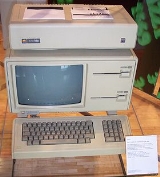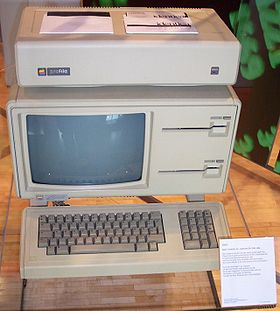
Apple ProFile
Encyclopedia

Apple Computer
Apple Inc. is an American multinational corporation that designs and markets consumer electronics, computer software, and personal computers. The company's best-known hardware products include the Macintosh line of computers, the iPod, the iPhone and the iPad...
, initially for use with the Apple III
Apple III
The Apple III is a business-oriented personal computer produced and released by Apple Computer that was intended as the successor to the Apple II series, but largely considered a failure in the market. Development work on the Apple III started in late 1978 under the guidance of Dr. Wendell Sander...
personal computer
Personal computer
A personal computer is any general-purpose computer whose size, capabilities, and original sales price make it useful for individuals, and which is intended to be operated directly by an end-user with no intervening computer operator...
. The original model had a formatted capacity of 5 MB
Megabyte
The megabyte is a multiple of the unit byte for digital information storage or transmission with two different values depending on context: bytes generally for computer memory; and one million bytes generally for computer storage. The IEEE Standards Board has decided that "Mega will mean 1 000...
and connected to a special interface card that plugged into an Apple III slot. In 1983 Apple offered a ProFile interface card for the Apple II
Apple II
The Apple II is an 8-bit home computer, one of the first highly successful mass-produced microcomputer products, designed primarily by Steve Wozniak, manufactured by Apple Computer and introduced in 1977...
, with software support for ProDOS
ProDOS
ProDOS was the name of two similar operating systems for the Apple II series of personal computers. The original ProDOS, renamed ProDOS 8 in version 1.2, was the last official operating system usable by all Apple II series computers, and was distributed from 1983 to 1993...
and Apple Pascal
Apple Pascal
Apple Pascal was a language and operating system based on the UCSD Pascal system.Apple Pascal refers to an operating system for the Apple II family of computers released in August 1979 between the Apple DOS 3.2 and 3.3 versions. The system was included as part of a software/hardware package adding...
.
Also in 1983, Apple introduced the Lisa
Apple Lisa
The Apple Lisa—also known as the Lisa—is a :personal computer designed by Apple Computer, Inc. during the early 1980s....
computer, which was normally sold with a ProFile. The ProFile could be connected to the built-in parallel port of the Lisa, or to a port of an optional dual-port parallel interface card. Up to three such interface cards could be installed, so in principle up to seven ProFile drives could be used on a Lisa.
The 5 MB ProFile was Apple's first hard drive, and was introduced in September 1981 at a price of US$ 3499. Later a 10 MB model was offered, but required an upgraded PROM
Programmable read-only memory
A programmable read-only memory or field programmable read-only memory or one-time programmable non-volatile memory is a form of digital memory where the setting of each bit is locked by a fuse or antifuse. Such PROMs are used to store programs permanently...
/interface card to recognize the additional 5MB.
Internally, the ProFile consisted of a bare Seagate
Seagate Technology
Seagate Technology is one of the world's largest manufacturers of hard disk drives. Incorporated in 1978 as Shugart Technology, Seagate is currently incorporated in Dublin, Ireland and has its principal executive offices in Scotts Valley, California, United States.-1970s:On November 1, 1979...
ST-506
ST-506
The ST-506 was the first 5.25 inch hard disk drive. Introduced in 1980 by Seagate Technology , it stored up to 5 megabytes after formatting and cost $1500. The similar 10 MB ST-412 was introduced in late 1981. Both used MFM encoding...
stepper motor drive and mechanism, without the usual Seagate electronics, a digital and an analog circuit board designed and manufactured by Apple, and a power supply.
Later Lisa models could be configured with an internal 10 MB "Widget" voice-coil drive with a proprietary controller designed and built entirely by Apple, but the Widget was never offered as an external product for use with other Apple computers.
Apple did not offer another hard drive until it released the Hard Disk 20
Hard Disk 20
The Macintosh Hard Disk 20 was the first hard drive developed by Apple Computer specifically for use with the Macintosh 512K. Introduced on September 17, 1985, it was part of Apple's long awaited solution toward completing the Macintosh Office announced in January 1985...
designed specifically for the Macintosh 512K
Macintosh 512K
The Macintosh 512K Personal Computer, also known as the "Fat Mac", is the second of a long line of Apple Macintosh computers, was the first update to the original Macintosh 128K. It was virtually identical to the previous Mac, differing primarily in the amount of built-in memory , which quadrupled...
in September 1985 which could not be used on the Apple II or III families, or Lisa series. The ProFile could not be used on the Macintosh or the Apple IIc
Apple IIc
The Apple IIc, the fourth model in the Apple II series of personal computers, was Apple Computer’s first endeavor to produce a portable computer. The end result was a notebook-sized version of the Apple II that could be transported from place to place...
computer (for which Apple never offered an external hard disk drive of any kind).
By September 1986, the ProFile would be superseded by the introduction of the first cross-platform Hard Disk 20SC
Hard Disk 20SC
The Apple Hard Disk 20SC was Apple's first SCSI based hard drive for the Apple II family as well as the Macintosh and other third party computers using an industry standard SCSI interface.-History:Released...
SCSI-based drive for the Macintosh and interface card for the Apple II family (excluding the IIc series, which had no SCSI interface of any kind) and Lisa/XL series.

